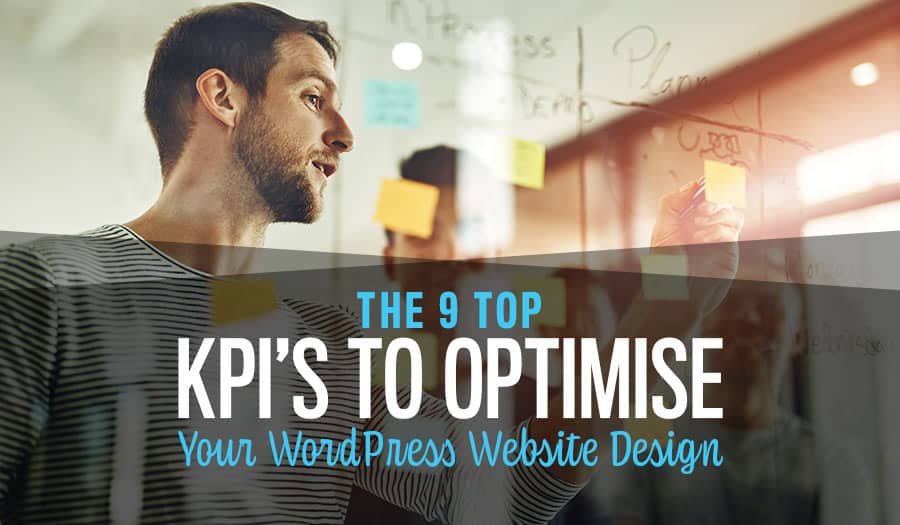So you’ve built the most beautiful website in your industry. With the partnership of a WordPress web design agency, you’ve set up an online presence to be proud of, aiming to highlight your services and engage your users. Now comes the tricky part: will it actually help to grow your revenue and business? Here are The 9 Top WordPress Website KPI’s to Monitor.
The tricky truth is that you’ll never know the answer without the right analytics and measurement strategy. Even beautiful websites don’t always attract, engage, and convert users at even industry average rates. The only way to find out, to truly test the success of your WordPress website design, is to make it a habit to track its success.
That sounds complicated. Fortunately, it doesn’t have to be. You just need to know how to track success on WordPress and then build reports focusing on the right metrics to provide real, actionable insights. This post will help you do both.
How to Track Success on Your WordPress Site
The most common way to track your quantitative is through Google Analytics. Once installed, it provides comprehensive access to a wide range of reports, dashboards, and audience insights.
If you’ve worked with a partner on web design, simply asking them about the Google Analytics install might be all you need. If you’re on your own, this tutorial comprehensively walks through the process of marrying the two platforms and measuring the traffic and behaviours on your site.
The 9 Top WordPress Website KPI’s to Monitor
- Total and Unique Web Visits/Sessions
- Return Visitor Percentage
- Traffic Sources
- Bounce Rate (Page-Specific and Site-Wide)
- Exit Rate and Top Exit Pages
- Average Session Duration
- Conversion Rate (Tracked by Conversion Type)
- User Demographics
- Blog Engagements and Link Sharing
Figuring out the how, of course, can only be the beginning. You also need to know exactly what to track, especially in a comprehensive solution like Google Analytics. While all available metrics have at least some value, these 9 tend to be the most insightful key performance indicators in allowing you to take action and improve your web presence over time.
1. Total and Unique Web Visits/Sessions
Let’s get the easy one out of the way: Page visits (sometimes referred to as sessions) tell you how many people visit your website in a given time. Tracking this top-level metric over time, especially comparing different time periods, allows you to benchmark how it performs over time and whether you need to make any changes.
There are two important caveats for website owners and marketers to keep in mind, though:
- Unique page visits are a separate metric, and might be even more important/relevant. The same user visiting your page 3 times counts as 3 page views, but only one unique view.
- Devices matter for unique page visits. Using the example above, the same visitor using three separate devices for each visit will count as three unique views.
2. Return Visitor Percentage
One level down from total page views is your return visitor rate, which (as the name suggests) tracks how many of your users liked the website enough that they returned. A high return visitor percentage is a good thing. It suggests that your site and its content is relevant enough for your audience to keep coming back.
Beyond tracking this rate for the entire website, you can also take it down in nuance. The return visitor percentage of individual pages, like your pricing page or new blog posts published through WordPress, are especially relevant to track high-intent users who are likely to become customers.
How to improve your average website Return Visitor Percentage:
- Personalise your website content: A personalised experience leads to higher engagement and more returning visitors. Use AI/ML-powered recommendations and analytics tools to tailor the webpages for different user segments.
- Keep optimizing your website’s loading speed: Users are more likely to return if your page loads faster, so make sure your pages are optimized accordingly.
- Run targeted campaigns: Start running targeted campaigns to boost your return visitor rates and ensure the right users are engaging with your content.
- Engage with visitors on social media: Connecting with visitors through social media is a great way to build relationships and keep them coming back for more.
- Include CTAs: Be sure to include calls-to-action on each page so that visitors know how to take the next step.
- Analyse user behaviour: Use analytics tools to analyse user behaviour on your website and find out what content works best for which audiences. This will help you improve your website and create more tailored experiences.
- Reward loyalty: Give your returning visitors a reward by offering discounts and loyalty programmes. This will encourage them to keep coming back for more.
- Send regular updates: Keep your returning visitors engaged by sending them regular updates about new content or offers.
- Keep content fresh: Make sure you are frequently updating your content so that it stays relevant and engaging to your visitors.
3. Traffic Sources
Do you know how visitors get to your website? Most analytics platforms track traffic sources, which tell you just that. Those sources, in turn, can provide you with a wide range of insights:
- High visitor percentages from organic search suggest that your SEO strategy is working.
- High visitor percentages from social media mean your tactics on those channels are effective, and your content is shared widely.
- High direct traffic means your offline and awareness marketing is good enough to prompt users to enter your website’s URL directly into their browser.
- High referrals suggest your website’s content being shared frequently on other websites, a boon for SEO and awareness.
Keep in mind that you can also use this metric as a qualifier for any of the other KPIs mentioned here. Filtering your bounce rate, session duration, or conversion rate through the traffic source gives you deeper insight into the success and connection of these sources to your website.
4. Bounce Rate (Page-Specific and Site-Wide)
Your bounce rate is as simple as it’s important: it measures the percentage of users that leave (or ‘bounce’) after only viewing the page at which they first arrive. That applies to the majority of visitors; a typical bounce rate is typically between 50 and 60 per cent. Still, it pays to optimise your web design against it.
Your bounce rate can be tracked for both your website as whole and individual pages. The latter is especially relevant, allowing you to make simple optimisations within WordPress should it go beyond your benchmark. Site speed is a major component, so compressing images, reducing plug-ins, and simplifying the code can all lead to a lower, more attractive bounce rate.
How to improve your average website Bounce Rate:
- Optimize Your Web Pages for Speed
- Write Compelling Content That Engages Visitors
- Provide Easy Navigation Around Your Site
- Use Clear Calls-to-Action to Guide Users
- Utilize Exit Intent Popups
- Segment Your Audience and Tailor Content Accordingly
5. Exit Rate and Top Exit Pages
Don’t confuse the bounce rate with its close relative, the exit rate. This KPI, tracked on a page level, helps you understand exactly how many of your page visitors leave your website from that page.
Unlike bounce rate, that’s not necessarily a bad thing. You might lead your audience to call your business or enter a third-party payment system on a conversion page. That’s technically an exit, but one that actually drives new business.
Still, this metric helps you gain a better grip of your user journey. Learn about your top exit pages, and make design optimisations to ensure they line up with what you want your users to do.
6. Average Session Duration
Just how long do your visitors stay on your website once they get there? That’s what this KPI intends to tell you. It’s an estimate, but it’s still valuable in helping you determine whether your website is easy to navigate, has good UX, and contains what your audience is looking for.
Different industries tend to have different session durations, so benchmarking this metric is key. If yours is shorter than average, adding more engaging content and building a more natural duration path may help you increase it again.
How to improve your average website session duration:
- Have a clear navigation structure
- Prioritise content that is relevant to your target audience
- Include calls to action with enticing offers or rewards
- Leverage design elements like animations to add visual interest and engagement
- Create pathways on the website so visitors can find what they are looking for quickly and efficiently
7. Conversion Rate (Tracked by Conversion Type)
Naturally, you want your audience to use your website in order to move towards becoming customers. They likely get there in a few major steps, typically called conversions. Tracking your conversion rate, as a result, helps you determine exactly how well your site is performing in actually gaining customers.
It’s important, however, to distinguish between the different types of conversions you should track. The three major categories here include:
- Micro conversions, which are general indicators of a user’s interest. This might include visiting your pricing page or spending more than three minutes on your website at a time.
- Lead conversions, or the number of visitors filling out a form to learn more. While they might not be ready to buy yet, they can now enter more targeted marketing streams.
- You can likely only track customer conversions if you sell your product or service through your website. Still, they’re the most valuable conversion type to track your ROI.
Keep a close eye on your conversion rate across these three categories. If a specific page or traffic source performs especially well, it’s worth prioritising.
How to improve your average website Conversion Rate:
- Optimise your website design and layout.
- Make sure the content on your pages is tailored to meet the needs of your customers
- Utilise compelling calls-to-action that encourage visitors to take action
- Use A/B testing to identify which changes are most effective
- Add special offers or discounts to incentivise customers
- Incorporate remarketing strategies to reach out to those who have visited your website before
These strategies will help you make better-informed decisions about how you drive traffic and optimise conversions. Leveraging the power of data and analytics can also assist in understanding customer behaviour on your site and give you insight into which marketing channels are.
8. User Demographics
Your analytics platform can tell you quite a bit about your website’s audience. Through browser data, you can learn information like age range, geographic information, and the device type used to access your online presence. Turn it into a KPI by using it both as a check against your marketing efforts and as a qualifier for your other tracking metrics.
The first is simple. Your visitor demographics should line up with the audience you’ve defined as your target, your most likely customers. If it doesn’t, tweaks are necessary. But you can also analyze your conversion rate, session duration, etc., through the lens of these demographics, helping you understand just what segment of your target audience most successfully navigates your website.
9. Blog Engagements and Link Sharing
Websites built on WordPress have the advantage of a built-in, powerful blogging platform. Publishing a regular blog has significant business benefits. That’s why the final KPI we’ll discuss focuses specifically on tracking the success of your WordPress blog.
It’s actually a performance indicator made up of a few different metrics:
- Comments on your posts
- Shares of your posts
- Scroll depth, or how far your audience actually reads
- Referrals to your posts from other websites indicating indirect link shares.
Combine them, and you get a comprehensive overview of your blog posts’ performance. You can use that overview to decide what type of content your audience likes to read and what attracts them to your website (and business) to begin with.
What Comes Next: Using Website Metrics for Tangible Web Design Improvements
All of the WordPress Website KPI’s metrics are important to understand whether your website is functioning as it should to attract new users and eventual customers. But of course, tracking and understanding them is only the beginning. In addition, you need to leverage them actually to improve your WordPress web design.
That can be admittedly difficult. It’s too easy to get lost in the mass of numbers within a solution like Google Analytics. Fortunately, you’re not on your own. A reliable web design partner, especially one with expertise in WordPress, can help you not just track and understand the metrics but convert them into tangible improvements for your online presence. Contact us to learn more if you’re ready to take that step.
Take your business to the next level with a Pixel Fish Website.
Check out some of our latest Website Design projects.
Further Reading
10 Tips that Maximise Your WordPress Website Design ROI
12 Tactics to Increase Your WordPress Website Speed
10 Best Practices for Installing New WordPress Plugins
Could Virtual Reality Websites Be the Future of Web Design?
5 of The Best Features Of DIVI Wordpress Theme
10 Tips for Designing the Perfect Accounting Website
How to Create Senior-Friendly Website Design
Divi WordPress Theme
10 Best Practices for a Successful WordPress Website Design Project
Top 8 Advanced WordPress Features and Plugins to Beat Your Competition
11 of the Best Divi WordPress Theme features you should know
The 9 Best Google Analytics Metrics to Track for Your Website
How to Keep Your Website Relevant so Your Customers Return for More
6 Tips to Increase Your Ecommerce Conversion Rate
5 Ways to Improve Your Website Conversion Rate Through Web Design
Top 3 Ways Website Design Impacts SEO For Your Business



